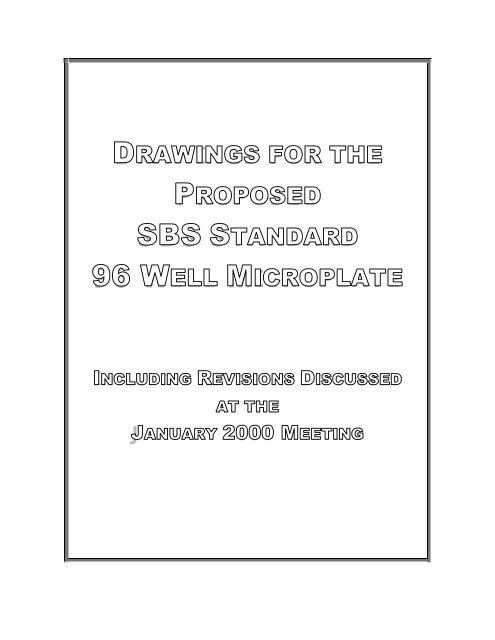drawings for the proposed sbs standard 96 well microplate - SLAS
drawings for the proposed sbs standard 96 well microplate - SLAS
drawings for the proposed sbs standard 96 well microplate - SLAS
Create successful ePaper yourself
Turn your PDF publications into a flip-book with our unique Google optimized e-Paper software.
DRAWINGS FOR THE<br />
PROPOSED<br />
SBS STANDARD<br />
<strong>96</strong> WELL MICROPLATE<br />
INCLUDING REVISIONS DISCUSSED<br />
AT THE<br />
JANUARY 2000 MEETING
06-06-2000 Martin Popoloski, David Kenney (Corning Incorporated)<br />
The following drawing, representing <strong>the</strong> <strong>proposed</strong> <strong>96</strong> <strong>well</strong> <strong>microplate</strong> <strong>standard</strong>, has been revised based on <strong>the</strong> last<br />
SBS sub committee meeting held at Lab Automation in January. The goal is to have a drawing which is concise,<br />
complete, and which will be interpreted consistently worldwide. The drawing <strong>standard</strong> used is ASME Y14.5M-<br />
1994. The SBS proposal used to revise this drawing is <strong>the</strong> revised January 2000 version, which can be seen in Marc<br />
Feiglin’s (Merck) e-mails of March 2, 2000 and again on April 24, 2000.<br />
In his e-mail, Marc has outlined four points discussed at <strong>the</strong> meeting:<br />
1- The <strong>standard</strong> will be as specified in <strong>the</strong> <strong>drawings</strong>. The text is only meant as a clarification and is not <strong>the</strong> actual<br />
<strong>standard</strong>:<br />
The revised drawing (DWG102005 Rev.X2, 11 pages) (<strong>the</strong> drawing number is <strong>for</strong> our internal file reference only) is<br />
in <strong>the</strong> same basic <strong>for</strong>mat as <strong>the</strong> original but does have a few changes. The title block of <strong>the</strong> drawing contains <strong>the</strong><br />
lines “PROPOSED SBS STANDARD”, “<strong>96</strong> WELL MICROPLATE” and a line with <strong>the</strong> number of <strong>the</strong> SBS<br />
<strong>proposed</strong> <strong>standard</strong> (i.e.: “SBS-1a”, “SBS-2”, etc.). Keeping in mind that <strong>the</strong> text of <strong>the</strong> SBS proposal consists of a<br />
number of separate or independent <strong>standard</strong>s, <strong>the</strong>re is a separate sheet (or page) of <strong>the</strong> drawing <strong>for</strong> each <strong>proposed</strong><br />
SBS <strong>standard</strong>. Where appropriate, separate <strong>standard</strong>s are combined (e.g.: SBS-3a, 3b, & 3c are all shown on sheet<br />
3). Sheet 5 is a composite drawing showing all <strong>the</strong> <strong>proposed</strong> <strong>standard</strong>s rolled into a single drawing. This composite<br />
may be what we want to ultimately issue as a <strong>standard</strong>.<br />
The explanatory sketches (pages 6-11)(to illustrate principles involved and/or interpretation) have been moved to <strong>the</strong><br />
back of <strong>the</strong> drawing as an appendix. We have found <strong>the</strong>se to be quite useful in explaining <strong>the</strong> <strong>drawings</strong> and feel <strong>the</strong>y<br />
should remain as part of <strong>the</strong> <strong>standard</strong>. The so called “Centerline Method” (drawing DWG102006) and <strong>the</strong> “B” size<br />
composite page include in <strong>the</strong> original package have been dropped.<br />
2- The primary units of measure will remain metric, but we will include <strong>the</strong> non-metric conversion. Metric units are<br />
to be rounded to 2 decimal places, non-metric to three:<br />
The drawing has been updated. In order to be very specific and to avoid any confusion with interpretation of <strong>the</strong><br />
rounding of <strong>the</strong> inch conversions, I decided to go with four place decimals <strong>for</strong> <strong>the</strong> English (inch) units (which has<br />
slightly changed some of <strong>the</strong> numbers specified in <strong>the</strong> text). Note that <strong>for</strong> <strong>the</strong> metric (millimeter) dimensions, <strong>the</strong><br />
numbers used contain a leading zero be<strong>for</strong>e <strong>the</strong> decimal point but no trailing zeros (<strong>for</strong> <strong>the</strong> two decimal places). No<br />
leading zeros are used <strong>for</strong> <strong>the</strong> English (inch) dimensions. This is per <strong>the</strong> ASME Y14.5M-1994 <strong>standard</strong> (sections 1.5<br />
& 1.6).<br />
3-Well locations will be specified from <strong>the</strong> plate edge not <strong>the</strong> plate center:<br />
As stated, <strong>the</strong> <strong>well</strong>s have been dimensioned from <strong>the</strong> edges (A-1 corner). We did however agree to maintain <strong>the</strong><br />
basic symmetry of <strong>the</strong> plate design, (i.e.: “on center”). In order to maintain perfect symmetry and maintain <strong>the</strong> two<br />
place decimals (as detailed in item #2 above) I took <strong>the</strong> liberty of changing <strong>the</strong> overall width dimension very<br />
slightly. It is understood that this change is subject to <strong>the</strong> approval of <strong>the</strong> sub-committee.<br />
The overall width was changed from 85.47 mm to 85.48 mm (3.365” to 3.3654”) <strong>for</strong> an increase of 0.01 mm<br />
(0.0004”).<br />
4-The corner notch will be removed from <strong>the</strong> <strong>drawings</strong> since it is not specified in <strong>the</strong> <strong>standard</strong>:<br />
Although we did agree to this, my meeting notes indicate we also agreed that; if a “corner notch” is used, it is not to<br />
extend into <strong>the</strong> “flange”. In order to call this out, we do show <strong>the</strong> corner notch (at <strong>the</strong> A-1 location) with a note that<br />
reads “Quantity and location of chamfer(s) is optional. If used <strong>the</strong> chamfer must not include <strong>the</strong> flange.” Reference<br />
note # 7 on pages 1 & 5 of <strong>the</strong> drawing.<br />
We hope that <strong>the</strong>se revisions to <strong>the</strong> drawing will help to condense and clarify <strong>the</strong> <strong>proposed</strong> SBS <strong>96</strong> <strong>well</strong> <strong>microplate</strong><br />
<strong>standard</strong> as it stands today. We also recognize that not everyone who might have wished to have been <strong>the</strong>re had <strong>the</strong><br />
opportunity to attend <strong>the</strong> January meeting. Some have since used <strong>the</strong> listserver to express concern over <strong>the</strong> corner<br />
notch and some over <strong>the</strong> flange height. We would like to urge all interested parties to attend <strong>the</strong> sub-committees<br />
meeting at <strong>the</strong> Drug Discover Show this August in Boston to help resolve <strong>the</strong> remaining issues.
















